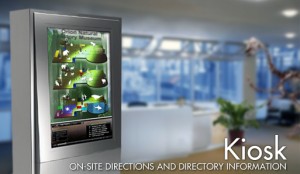Computing Directions
Graphical-Driven Wayfinding System: pulls up, on-request, pre-made maps with directions. This ‘cutting-corners’ technique is mostly used by developers who do not have the knowledge of ‘computing directions’ based on fastest, easiest, preferred, emergency,closed off, one-way or two-way and accessible labels of the individual portions of the total walk-way, road-way or hallway structure.
For real-situation changes, like in the lay-out of one of your floors, or of your building or your campus you have to turn to your developer. He will then make new pre-made graphical maps of all potential routes, integrates them into the wayfinding system and then has to upload all the kiosks or website. Cumbersome, slow and extremely expensive.
Data-Driven
As mentioned earlier, the outdoor wayfinding market leaders calculate directions and this is with good reason. How else can you manufacture a sensible direction plan on-the-fly from millions of roads, crossings, one-way streets in combination with the -always changing- position of the car?
In reality this means that all variables (roads, exits, ramps, intersections, etc.) with their attributes (toll-road, one-way/two-way, interstate or US high-way) have been given a number that indicates some kind of importance.
“Calculating”
The end-result of the calculation is the fastest route (with the highest importance), unless you indicated that you want to avoid toll-roads.
Key characteristics of a data-base driven wayfinding application:
- It knows where all locations are on the grid
- Every location can be a starting point or an end-point
- It knows the locations of every single hallway and intersection on the grid
- By computing it can provide either the fastest route, preferred route, bypass route, alternate route, accessible route or temporary route on-the fly
- Highly flexible, expandable and maintainable by the client itself, after delivery
A data-driven wayfinding system is cheaper to make, and cheaper and easier to manage (Hospitals, Universities, Government Buildings, Cemeteries, Airports). And frankly, for large projects, the only option.
There is another advantage of a data-driven wayfinding system over graphical, and that is that data-driven wayfinding systems, by character, make for a very easy technical upgrade, from On-Site wayfinding to Online wayfinding to Mobile wayfinding.
Some wayfinding projects use an engine that uses pre-made maps, with pre-marked destinations and pre-drawn directional lines, and display these on request. For example: 1(one) touchscreen display in the lobby, which allows visitors to show directions to 10(ten) end-destinations. So the wayfinding system has 10 different maps stored and pulls these up when the corresponding request is made. Graphical-driven wayfinding works fine for very small projects. If you represent a hospital or other large buildings, this will not work for you.
Graphical driven Wayfinding Engine: How did it come about?
The graphical based wayfinding system founds its existence in the fact that clients went to their designer bureau and asked them for an interactive wayfinding system. After all, that is where they always went if they had other wayfinding requests.
The designer, thinking in line with his expertise, came up with the solution of having multiple maps ‘ready’, all with different destinations and routes highlighted, to be displayed on request. Maybe the designer could automate this himself or used an IT company to integrate these maps into a interactive application.
All in all, a very logical process. And its definitely a way of supplying directions.
However, there is a catch, a very costly catch. For almost every change, you have to go back to the developer and pay big bucks.
Hospital – Health Care Buildings
I take the Hospital building as an example because that is the segment that is looking heavily into interactive wayfinding at the moment.
Hospitals, especially the older ones, are always changing due to renovations, reorganizations or the addition of new sections. They constantly have to keep up with growth, new technologies and new requirements. Their reality is a moving target.
Interactive Wayfinding in Hospitals
Implementing an interactive wayfinding system makes sense for a Hospital since the wayfinding application reality is easily updated to match the real life environment. Its faster and a lot cheaper than updating, for example, the static signage.
An interactive wayfinding system also gives the hospital and its visitors the advantages of modern technology, like offering directions through a kiosk (I prefer LCD-touch for hospital, see ‘Hospital Wayfinding’), Webpage or Mobile Phone with department-to-department directions.
Wrong Way! Go Back!
A lot of Hospitals make the right choice of implementing an interactive wayfinding system, but then they take the wrong turn and sign up with a developer who makes a graphical wayfinding system. Nobodies fault, but an expensive misstep none-the-less.
Expensive out of pocket costs, expensive to maintain and because the Hospital cannot make most changes them self, they are at the disposal of the developer when the updating of the system will be done. Since the wayfinding system is graphical driven, the graphical designer has to make a lot of the changes, which is very labor intensive (read: takes some time).
Data-Driven Wayfinding is the way to go. Ask for it!
Here are a couple of check marks:
- Can I block off a Hallway?
- Can the system automatically compute re-routes?
- Can I alter the routes myself to make (temporary) preferred routes?
- Can I change the location of a department and will all routes automatically adjust as well?
- If an elevator (escalator) doesn’t work, can I disable it in the system and will all directions automatically reset offering detours?
Anyway, if you don’t believe me, just ask Google, or Garmin.
###
www.here2theresoftware.com
Phone: USA 814 – 342 – 3120
support@here2theresoftware.com

